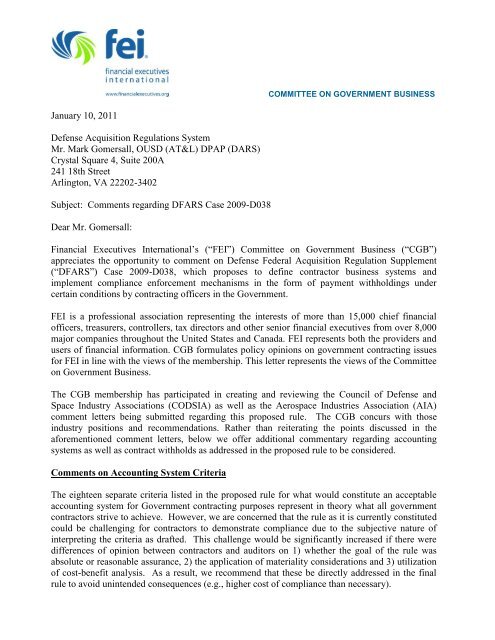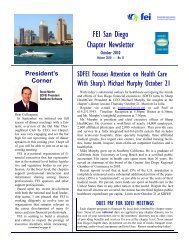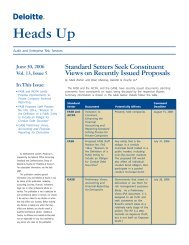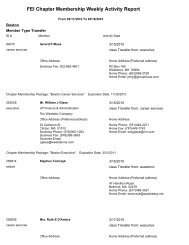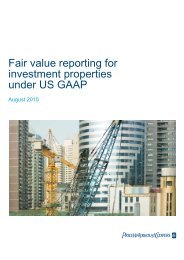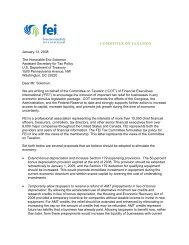letter - Financial Executives International
letter - Financial Executives International
letter - Financial Executives International
Create successful ePaper yourself
Turn your PDF publications into a flip-book with our unique Google optimized e-Paper software.
January 10, 2011<br />
Defense Acquisition Regulations System<br />
Mr. Mark Gomersall, OUSD (AT&L) DPAP (DARS)<br />
Crystal Square 4, Suite 200A<br />
241 18th Street<br />
Arlington, VA 22202-3402<br />
Subject: Comments regarding DFARS Case 2009-D038<br />
Dear Mr. Gomersall:<br />
COMMITTEE ON GOVERNMENT BUSINESS<br />
<strong>Financial</strong> <strong>Executives</strong> <strong>International</strong>’s (“FEI”) Committee on Government Business (“CGB”)<br />
appreciates the opportunity to comment on Defense Federal Acquisition Regulation Supplement<br />
(“DFARS”) Case 2009-D038, which proposes to define contractor business systems and<br />
implement compliance enforcement mechanisms in the form of payment withholdings under<br />
certain conditions by contracting officers in the Government.<br />
FEI is a professional association representing the interests of more than 15,000 chief financial<br />
officers, treasurers, controllers, tax directors and other senior financial executives from over 8,000<br />
major companies throughout the United States and Canada. FEI represents both the providers and<br />
users of financial information. CGB formulates policy opinions on government contracting issues<br />
for FEI in line with the views of the membership. This <strong>letter</strong> represents the views of the Committee<br />
on Government Business.<br />
The CGB membership has participated in creating and reviewing the Council of Defense and<br />
Space Industry Associations (CODSIA) as well as the Aerospace Industries Association (AIA)<br />
comment <strong>letter</strong>s being submitted regarding this proposed rule. The CGB concurs with those<br />
industry positions and recommendations. Rather than reiterating the points discussed in the<br />
aforementioned comment <strong>letter</strong>s, below we offer additional commentary regarding accounting<br />
systems as well as contract withholds as addressed in the proposed rule to be considered.<br />
Comments on Accounting System Criteria<br />
The eighteen separate criteria listed in the proposed rule for what would constitute an acceptable<br />
accounting system for Government contracting purposes represent in theory what all government<br />
contractors strive to achieve. However, we are concerned that the rule as it is currently constituted<br />
could be challenging for contractors to demonstrate compliance due to the subjective nature of<br />
interpreting the criteria as drafted. This challenge would be significantly increased if there were<br />
differences of opinion between contractors and auditors on 1) whether the goal of the rule was<br />
absolute or reasonable assurance, 2) the application of materiality considerations and 3) utilization<br />
of cost-benefit analysis. As a result, we recommend that these be directly addressed in the final<br />
rule to avoid unintended consequences (e.g., higher cost of compliance than necessary).
Mr. Gomersall<br />
January 10, 2011<br />
Page 2 of 7<br />
An unclear rule could cause the implementation to result in effects that are contrary to the Guiding<br />
Principles found in FAR Part 1 as noted below;<br />
FAR Part 1.102-2(b)(1) In order to ensure that maximum<br />
efficiency is obtained, rules, regulations, and policies should be<br />
promulgated only when their benefits clearly exceed the costs of<br />
their development, implementation, administration, and<br />
enforcement. This applies to internal administrative processes,<br />
including reviews, and to rules and procedures applied to the<br />
contractor community.<br />
FAR Part 1.102-2(c)(2) To achieve efficient operations, the System<br />
must shift its focus from “risk avoidance” to one of “risk<br />
management.” The cost to the taxpayer of attempting to eliminate<br />
all risk is prohibitive. The Executive Branch will accept and<br />
manage the risk associated with empowering local procurement<br />
officials to take independent action based on their professional<br />
judgment.<br />
The interplay between the objectives of internal controls, their cost and benefit, as well as the risk<br />
of control failures is a balance that industry continually addresses. This has been particularly<br />
evident in recent years by the compliance with the internal control provisions of the Sarbanes-<br />
Oxley Act of 2002 that publically traded companies must follow in connection with their internal<br />
controls over financial reporting.<br />
Industry practices coincide with the FAR Guiding principles for “risk management” with respect to<br />
internal control systems. In our view recently published guidance from the DCAA (Defense<br />
Contract Audit Agency) as discussed further in these comments suggests a “risk avoidance”<br />
approach, deeming all deficiencies that are found related system control objectives as<br />
“significant”.<br />
Control systems within an accounting environment may take different forms and have different<br />
attributes such as manual, automated, preventive and detective controls. The design and cost of<br />
each control should be based upon the potential risk associated with the objective that is being<br />
addressed. The lower the tolerance for risk in establishing the controls the higher the cost to<br />
develop, implement and maintain those systems.<br />
The confluence of this proposed rule together with the DCAA guidance that is focused on risk<br />
avoidance rather than risk management has the potential of significantly increasing the cost of<br />
business systems at contractors which is passed on to the Government, without corresponding<br />
benefit to the taxpayer or war fighter over the long run.<br />
With regard to some of the specific criteria included in the rule for Accounting Systems criterion<br />
number 8 requires "Periodic monitoring of the system" without a definition of what the expectation<br />
or frequency of the reviews should be with this rule. Monitoring is a fundamental and important<br />
aspect of any internal control system. As written, the rule does not recognize leading practices that<br />
are being implemented in industry through automated continuous monitoring and exception
Mr. Gomersall<br />
January 10, 2011<br />
Page 3 of 7<br />
reporting in areas where those types of reviews can be applied. In recognition of the various ways<br />
in which monitoring systems can be implemented, we recommend the word “periodic” be<br />
eliminated from the criteria.<br />
Accounting system criteria number 12 requires the system to exclude unallowable costs in<br />
accordance with FAR and contract terms from government contracts. Contractors have established<br />
elaborate systems and controls to capture and exclude these costs. Contractors certify annually to<br />
the best of their knowledge that unallowable costs are excluded from their billings. However,<br />
based on the nature of these costs, at times they will avoid established controls. This is typically<br />
due to either human error or changes to prior interpretations and definitions in the nature of these<br />
costs by either contractors, the Government or the Courts.<br />
In establishing CAS 405 (Accounting for Unallowable Costs) the CAS Board provided guidance<br />
that this rule was to be implemented with reason. Specifically within the preambles to the<br />
publication of CAS 405 the board made the following statement:<br />
“With regard to the stated concern about overzealous<br />
implementation auditors and contracting officers, the Board has<br />
previously stated that the administration of its rules, regulation and<br />
Cost Accounting Standards should be reasonable. The Board<br />
anticipates that this rule of reason will be applied in the<br />
implementation of this Standard. Thus, where a good faith effort<br />
has been made by a contractor, in the development and<br />
implementation of his cost accounting rules, procedure and<br />
practices, to provide for identification of expressly unallowable<br />
costs, it is intended that inadvertent failure to properly classify a<br />
particular item of cost will not be regarded as a noncompliance”<br />
Despite this basis on which the rule was to be implemented, auditors routinely will issue CAS 405<br />
noncompliance audit reports when they encounter these issues as part of other reviews (typically<br />
incurred cost audits) irrespective of whether the company disagrees with the auditors’<br />
interpretation, or the cost represented an inadvertent error or is immaterial in amount. Previously<br />
these immaterial audit issues have been resolved between contracting officers and contractors, in<br />
accordance with the normal cadence of business activity. Under the proposed rule these previously<br />
immaterial issues may now be considered significant as they will constitute deficiencies resulting<br />
in withholds and disputes. Therefore we recommend this criterion be eliminated from the<br />
proposed rule since remedies already exist for contracting officers to protect the Government’s<br />
interest through the application of the CAS (Cost Accounting Standards) administration clause, as<br />
well as the FAR (Federal Acquisition Regulation) Allowable Cost and Payment clause at 52.216-7,<br />
for this aspect of contractor accounting practices.<br />
Accounting system criteria number 17 introduces the subjective and undefined terms "Adequate"<br />
and "Reliable" with respect to accounting systems providing data to be used to support follow-on<br />
acquisitions (proposals). CAS (Cost Accounting Standards) covered contractors already have the<br />
requirements from CAS 401 to disclose, bid and collect costs in a consistent fashion. Effectively<br />
this criterion is tying the basis of estimates (BOEs) for proposals to the accounting system, which<br />
is in our view inappropriate. The ability to articulate the nuanced difference between accounting<br />
transactions and proposal BOE rationale is not something that should be the subject of a FAR
Mr. Gomersall<br />
January 10, 2011<br />
Page 4 of 7<br />
clause or part of the terms in our contracts. This criterion will effectively eliminate a contractor’s<br />
prerogative or ability to establish the level of appropriate accounting for transactions without the<br />
consent of the regulators. The proposed rule has established contractor estimating systems as one<br />
of the six business systems that would be subject to withholds. The criteria in that portion of the<br />
rule have been established to insure estimating systems are working correctly. Inserting this<br />
criterion within the accounting system in our view is redundant and should be deleted. We view<br />
inclusion of this criterion as inequitable as it could lead to potentially a double counting of a single<br />
condition as two deficiencies first in the Accounting and then second in the Estimating system<br />
effectively doubling up of withholds for that single condition.<br />
Furthermore the rule does not allow for the adjudication of disputes prior to the implementation of<br />
withholds. Accounting system criteria number 18 requires contractor accounting practices to be in<br />
accordance with CAS (Cost Accounting Standards) and GAAP (Generally Accepted Accounting<br />
Principles). Most major contractors that are subject to CAS and DCAA oversight have ongoing<br />
disagreements or disputes regarding the interpretation and implementation of the CAS in their<br />
practices. It is not unusual for the DCAA in their audit reports to cite a contractor for an<br />
inadequacy in their systems, due to the contractor implementing CAS in a fashion that is not in<br />
agreement with the DCAA view. In certain circumstances even reasonable people cannot come to<br />
an agreement, which in the case of Government contracting leads to the courts for a decision.<br />
Contractors should not be subject to the undesirable effects of contract withholds on matters of<br />
disputed interpretation which await the decision of the judiciary. In the event of an adverse<br />
decision to a contractor, the Government’s position is protected through an interest assessment that<br />
would be applied to the matter at hand. In the case of these withholds in the event of an adverse<br />
decision to the Government, contractors would have suffered the undesirable effects of limited<br />
cash flow, throughout what is typically a lengthy litigation process.<br />
Comments on Risk and Materiality Considerations within Accounting systems<br />
DoD in the response to public commentary stressed the importance of materiality (item 33). “DoD<br />
disagrees with the assertion that business systems will be deemed inadequate and payments held<br />
for minor deficiencies.”<br />
DoD also asserted (item 4) that it is the policy of DCAA to report only deficiencies determined to<br />
be significant deficiencies or material weaknesses.<br />
However, in actual practice that assertion conflicts with published guidance issued by the DCAA,<br />
(reference December 19, 2008 MRD titled audit Guidance on Significant Deficiencies/material<br />
Weaknesses and Audit opinions on Internal Control Systems). This guidance instructs the auditor<br />
in clear terms that anything which is subject to DCAA review should be considered significant.<br />
The guidance states:<br />
“It is not necessary to demonstrate actual questioned cost to report<br />
a significant deficiency/material weakness. In addition, by limiting<br />
internal control audits to major contractors, DCAA only performs<br />
audits of contractor systems that are material to Government<br />
contract costs. As a result, internal control deficiencies identified<br />
in DCAA audits will generally have an impact or potential impact
Mr. Gomersall<br />
January 10, 2011<br />
Page 5 of 7<br />
to Government contract costs that is material. Therefore, a<br />
contractor’s failure to accomplish any applicable control objective<br />
should be reported as a significant deficiency/material weakness.”<br />
The Internal Control — Integrated Framework published by the Committee of Sponsoring<br />
Organizations of the Treadway Commission (COSO) is the most widely used framework in the<br />
U.S. for designing and implementing effective internal controls. COSO recognizes that “resources<br />
always have constraints, and entities must consider the relative costs and benefits of establishing<br />
controls.” COSO also acknowledges that “an internal control system, no matter how well<br />
conceived and operated, can provide only reasonable — not absolute — assurance to management<br />
and the board…” The clear record as published by the DCAA headquarters guidance is an<br />
expectation of perfection, which is contrary to not only the COSO internal control framework, but<br />
also to the commentary from DoD in the proposed rule and existing language in FAR Part 1.102-<br />
2(c)(2). This divergence of interpretation between good business practice, the published policy of<br />
DoD and the DCAA will create inefficiency in the process and add unnecessary cost to contractor<br />
systems not commensurate with the risk associated with deficiencies as they are perceived by the<br />
DCAA.<br />
Therefore we recommend that materiality and significant deficiency be defined in the proposed<br />
rule to avoid unintended consequences in implementation.<br />
Comments on punitive remedies within Subpart 242.7502(g) Mitigating the risk of<br />
accounting system deficiencies on specific proposals<br />
Within the commentary in the Federal register on this proposed rule (item 32) regarding the<br />
Legality of Withholds, the point is made that: “DoD is relying on the temporary percentage<br />
withholds, not as a penalty for a deficiency, but as representing a good-faith estimate sufficient to<br />
mitigate the Government’s risk, where the actual amounts are difficult to estimate or quantify.”<br />
However Subpart 242.7502(g) in this proposed rule introduces a punitive step whereby contracting<br />
officers can permanently decrement profit or fee on a proposal. A Contracting Officer could also<br />
unilaterally adjust contract prices where reopener clauses have been mandated on proposals under<br />
this new regime. Given the subjective nature and the application of judgment that will be applied<br />
in the Contracting Officers decisions for this rule, there should be additional language inserted into<br />
this subpart that would require the auditor’s or functional specialist’s report to the contracting<br />
officer to describe the deficiencies in sufficient detail to allow a full understanding of the<br />
deficiencies and the potential adverse impact to the Government. This report should estimate a<br />
discrete potential dollar impact of each cited deficiency, so the risk to the government can be<br />
quantified and assessed on an individual basis. The auditor should be required to list the criteria<br />
on which he based his conclusions.<br />
In the absence of this further requirement on the auditor or functional specialist, this subpart<br />
should be deleted from the final rule as it will lead to unnecessary disputes and is punitive to<br />
contractors beyond other measures already included in this rule.
Mr. Gomersall<br />
January 10, 2011<br />
Page 6 of 7<br />
Comments on contract withholds in the revised proposed rule.<br />
The CGB appreciates the reduction in withhold rates in this proposed rule from the prior version.<br />
However, the lack of dollar limitations at the contract level will clearly lead to withholds that<br />
grossly exceed the amount required to protect the interests of the U.S. Government.<br />
The proposed rule also fails to provide oversight when contracting officers direct withholds and do<br />
not evaluate corrective action plans in a timely manner. In order to ensure consistency and<br />
equitable treatment of contractors we recommend that the value withheld at the contract level be<br />
limited to $100,000 until authorization is received from DCMA headquarters to go beyond the<br />
limit. Furthermore DCMA headquarters authorization should be required at each of the following<br />
subsequent withhold thresholds: $250,000, $500,000, $1,000,000 and every million thereafter. The<br />
requirement to receive approval to go beyond specified limits will protect the contractor in<br />
situations when DCMA and DCAA lack the resources to perform reviews of corrective action<br />
plans or risk assessments in a timely manner.<br />
There would be benefit to a higher level approval as it would provide an escalation avenue to<br />
contractors when relations at the local level are strained. The approval of withholds above<br />
$100,000 by headquarters should be based on evidence that actual risk or harm in excess of the<br />
limit exists. An approval process will also provide DCMA headquarters with better insight on<br />
amounts being withheld which will ensure equitable treatment of contractors, helping to avoid<br />
Contract Dispute Claims, and identify situations when contractors may be at financial risk.<br />
The proposed rule also does not clearly address how contractors recover withheld amounts<br />
associated with a business system deficiency that is corrected but not before a deficiency in<br />
another business systems is identified. To avoid the potential for perpetual withholdings the<br />
proposed rule needs to provide guidance for releasing withholds in situations when deficiencies on<br />
multiple business systems overlap and the timing of corrective action plans differ. If perpetual<br />
withholds are experienced, and no actual harm takes place, industry believes there will be a basis<br />
to require prompt payment interest penalties as the exemption provided by law was intended for<br />
withholds taken for a limited time<br />
Comments on Applicability of Withholds by Contract Type:<br />
Within the FY 2011 National Defense Authorization Act, there is specific language with respect to<br />
the applicability of this proposed rule by contract type. Section 893(f)(3) defines a covered<br />
contract as follows:<br />
“(3) The term “covered contract” means a cost reimbursement<br />
contract, incentive type contract, time and materials contract or<br />
labor-hour contract that could be affected if the data produced by a<br />
contractor business system has a significant deficiency.”<br />
Accordingly the proposed rule must be adjusted to specifically exclude those contract types<br />
including Firm Fixed Price Contracts that have been discretely excluded by the Authorization Act.<br />
In closing the CGB has concerns that the proposed rule as written will lead to an increase in the<br />
cost of business systems without a commensurate benefit for that investment. The lack of due


